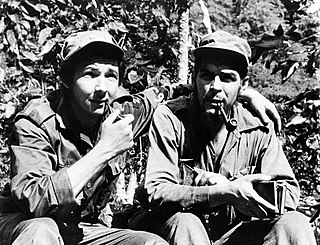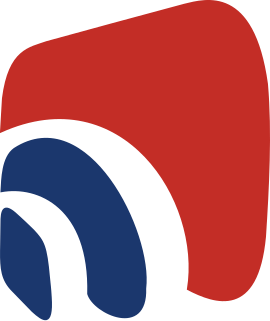Telecommunications in Cuba consists mainly of NTSC analog television, analog radio, telephony, AMPS, D-AMPS, and GSM mobile telephony, and the Internet. Telephone service is provided through ETECSA, mobile telephone service is provided through the Cellular Telephone Company of Cuba (CUBACEL) and Caribbean Cellular. Cuba's main international telecommunications links are through Intersputnik, with antiquated undersea telephone cables to the U.S., the West Indies, Spain, and possibly Italy.

The Cuban Revolution was an armed revolt conducted by Fidel Castro's revolutionary 26th of July Movement and its allies against the military dictatorship of Cuban President Fulgencio Batista. The revolution began in July 1953, and continued sporadically until the rebels finally ousted Batista on 31 December 1958, replacing his government with a revolutionary socialist state. 26 July 1953 is celebrated in Cuba as the Day of the Revolution . The 26th of July Movement later reformed along communist lines, becoming the Communist Party in October 1965.

Radio Televisión Martí is an American radio and television international broadcaster based in Miami, Florida, financed by the Federal government of the United States through the U.S. Agency for Global Media, which transmits news in Spanish to Cuba. Its broadcasts can also be heard and viewed worldwide through their website and on shortwave radio frequencies.

Radio Havana Cuba is the official government-run international broadcasting station of Cuba. It can be heard in many parts of the world including the United States on shortwave frequencies. Radio Havana, along with Radio Rebelde, Cubavision Television and other Cuban Radio and Television broadcasts to North, Central and South America via free-to-air programming from the Hispanisat satellite over the Atlantic Ocean and via Internet streaming.

Eduardo René Chibás Ribas was a Cuban politician who used radio to broadcast his political views to the public. He primarily denounced corruption and gangsterism rampant during the governments of Ramón Grau and Carlos Prío which preceded the Batista era. He believed corruption was the most important problem Cuba faced.

Hotel Tryp Habana Libre is one of the larger hotels in Cuba, situated in Vedado, Havana. The hotel has 572 rooms in a 25-floor tower at Calle 23 and Calle L.
The first television broadcast in Cuba was in 1950, by the small radio station Union Radio, soon followed by other stations. The broadcasts featured sport, soap operas, news, cooking shows, and comedy. Censorship was imposed following the 1952 coup by Fulgencio Batista. Color broadcasting began in 1958.
The 2006–2008 Cuban transfer of presidential duties was the handover of the title of president and presidential duties from longtime Cuban leader Fidel Castro to his brother Raúl Castro, the next-in-line-of-succession person in Cuba, following Fidel's operation and recovery from an undisclosed digestive illness believed to be diverticulitis. Although Raúl Castro exercised the duties of president, Fidel Castro retained the title of President of Cuba, formally the President of the Council of State of Cuba, during this period.
Radio Rebelde is a Cuban Spanish-language radio station. It broadcasts 24 hours a day with a varied program of national and international music hits of the moment, news reports and live sport events. The station was set up in 1958 by Che Guevara in the Sierra Maestra region of eastern Cuba, and was designed to broadcast the aims of the 26th of July Movement led by Fidel Castro. Transmitting on shortwave, Radio Rebelde also broadcast the latest combat news, music and spoken literature to the people of Cuba during the Cuban Revolution. Today, Radio Rebelde has forty-four transmitters on the FM dial covering 98 percent of the island of Cuba, plus a shortwave signal on the 60-meter band at 5.025 MHz, (5025 kHz) and several AM transmitters on various frequencies, most commonly 540, 550, 560, 600, 610, 620, 670, 710, and 770 kHz.
Censorship in Cuba is extensive. It has resulted in European Union sanctions from 2003 to 2008 as well as statements of protest from groups, governments, and noted individuals.

Henry Pollack is the Cuban born American host and founder of "Havana Rock," a radio program that has been on the air since May 1995, the Miami, Florida show on radio station WWFE 670 AM and has enjoyed a cult following since it first aired in 1995. The show has received much praise for its staunch anti-Communist stance and has been featured on CNN, BBC, ABC and Fox News. It is also the only radio show in South Florida that is completely bilingual. He is also the editor of an anti-Fidel Castro web sites on the net, which went online in 1998 as one of the first anti-Castro websites on the internet.

The Cuban Institute of Radio and Television is the government agency responsible for the control of radio and television broadcasters in Cuba.
Internet in Cuba is severely limited due to the United States embargo against Cuba. The United States refuses to allow an undersea cable to pass 100 miles from Cuba to Florida. Instead, Cuba's Internet connection is via the 6,000 mile ALBA-1 cable to Venezuela, which has had technical problems limiting its speed. The Cuban government also directly prevents access to certain websites. While preventing access to certain websites is present, it is not particularly extensive. Limited access to the Internet through limited internet infrastructure and high cost to access foreign websites is the main problem with Internet access in Cuba.

The University of Havana or UH is a university located in the Vedado district of Havana, the capital of the Republic of Cuba. Founded on January 5, 1728, the university is the oldest in Cuba, but not one of the first to be founded in the Americas. Originally a religious institution, today the University of Havana has 15 faculties (colleges) at its Havana campus and distance learning centers throughout Cuba.

CMQ was a Cuban radio and television station located in Havana, Cuba, reaching an audience in the 1940s and 1950s, attracting viewers and listeners with a program that ranged from music and news dissemination. It later expanded into radio and television networks. As a radio network it was a heated competitor of the RHC-Cadena Azul network.

The Cuban Revolution was not only fought by armed rebels on the battlefield but also through the propaganda campaigns designed and orchestrated by Fidel Castro and his rebel comrades. Propaganda in Cuba during revolution included Castro's use of personal interviews with journalists, radio broadcasts and publicity seeking operations that contributed significantly to the victory of the rebels over Fulgencio Batista's and provided insight into the successful propaganda campaign established by Castro after gaining power. The limited yet successful revolutionary propaganda apparatus transitioned into what Castro has called "one of the most potent weapons in his foreign policy arsenal." Today the Cuban government maintains an intricate propaganda machine that includes a global news agency, magazines, newspapers, broadcasting facilities, publishing houses, front groups, and other miscellaneous organizations that all stem from the modest beginnings of Castro's revolutionary propaganda machine.
Several independent Cuba-based digital media outlets offer alternative voices to censored state-run television, radio, and newspapers. Many of these new media ventures take the form of news outlets or webzines. These outlets may be used as platforms to critique the Socialist government, or to discuss issues or offer entertainment that the state-run media may ignore or consider taboo, such as sports and fashion.
Press freedom is an ongoing issue in Cuba. The country has ranked low on the Press Freedom Index, a list published by Reporters Without Borders which reflects the degree of freedom that journalists, news organisations, and netizens have in a country. Cuba has been ranked among the index's “least free" countries for a decade. In 2016, Amnesty International reported that the re-establishment of diplomatic relations between the United States and Cuba in December 2014 "renewed hope for an end to the US economic embargo, which has had a direct impact on the human rights of ordinary Cubans."

The Radiocentro CMQ Building complex consisted of a radio and television production facility and office building in Calle L and La Rampa in El Vedado, Cuba and it was modeled after Raymond Hood's 1933 Rockefeller Center in New York City. With 1,650 seats, the theater first opened on December 23, 1947 under the name Teatro Warner Radiocentro, it was owned by brothers Goar and Abel Mestre.













